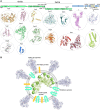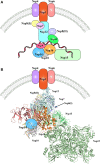Structural Characterization of SARS-CoV-2: Where We Are, and Where We Need to Be
- PMID: 33392262
- PMCID: PMC7773825
- DOI: 10.3389/fmolb.2020.605236
Structural Characterization of SARS-CoV-2: Where We Are, and Where We Need to Be
Abstract
Severe acute respiratory syndrome coronavirus 2 (SARS-CoV-2) has rapidly spread in humans in almost every country, causing the disease COVID-19. Since the start of the COVID-19 pandemic, research efforts have been strongly directed towards obtaining a full understanding of the biology of the viral infection, in order to develop a vaccine and therapeutic approaches. In particular, structural studies have allowed to comprehend the molecular basis underlying the role of many of the SARS-CoV-2 proteins, and to make rapid progress towards treatment and preventive therapeutics. Despite the great advances that have been provided by these studies, many knowledge gaps on the biology and molecular basis of SARS-CoV-2 infection still remain. Filling these gaps will be the key to tackle this pandemic, through development of effective treatments and specific vaccination strategies.
Keywords: COVID19; SARS-CoV-2; coronavirus; cryo-EM; structural biology.
Copyright © 2020 Mariano, Farthing, Lale-Farjat and Bergeron.
Conflict of interest statement
The authors declare that the research was conducted in the absence of any commercial or financial relationships that could be construed as a potential conflict of interest.
Figures



References
Publication types
LinkOut - more resources
Full Text Sources
Other Literature Sources
Miscellaneous

